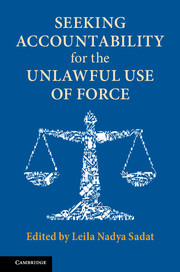Book contents
- Frontmatter
- Dedication
- Contents
- Notes on Contributors
- Foreword
- Preface
- Table of Cases
- Introduction
- PART I HISTORIC AND CONTEMPORARY PERSPECTIVES ON THE UNLAWFUL USE OF FORCE
- 1 The Status of Aggression in International Law from Versailles to Kampala – and What the Future Might Hold
- 2 Nuremberg and Aggressive War
- 3 The Tokyo International Military Tribunal and Crimes Against Peace (Aggression): Is There Anything to Learn?
- 4 The Just War in Ancient Legal Thought
- 5 Definitions of Aggression as Harbingers of International Change
- 6 International Humanitarian Law in an Age of Extremes: Unlawful Uses of Force by Non-State Actors
- PART II MECHANISMS FOR RESTRAINING THE UNLAWFUL USE OF FORCE AND ENHANCING ACCOUNTABILITY
- PART III THE ILLEGAL USE OF FORCE AND THE PROSECUTION OF INTERNATIONAL CRIMES
- PART IV IMAGINING A BETTER WORLD
- Epilogue
- Index
1 - The Status of Aggression in International Law from Versailles to Kampala – and What the Future Might Hold
from PART I - HISTORIC AND CONTEMPORARY PERSPECTIVES ON THE UNLAWFUL USE OF FORCE
Published online by Cambridge University Press: 21 May 2018
- Frontmatter
- Dedication
- Contents
- Notes on Contributors
- Foreword
- Preface
- Table of Cases
- Introduction
- PART I HISTORIC AND CONTEMPORARY PERSPECTIVES ON THE UNLAWFUL USE OF FORCE
- 1 The Status of Aggression in International Law from Versailles to Kampala – and What the Future Might Hold
- 2 Nuremberg and Aggressive War
- 3 The Tokyo International Military Tribunal and Crimes Against Peace (Aggression): Is There Anything to Learn?
- 4 The Just War in Ancient Legal Thought
- 5 Definitions of Aggression as Harbingers of International Change
- 6 International Humanitarian Law in an Age of Extremes: Unlawful Uses of Force by Non-State Actors
- PART II MECHANISMS FOR RESTRAINING THE UNLAWFUL USE OF FORCE AND ENHANCING ACCOUNTABILITY
- PART III THE ILLEGAL USE OF FORCE AND THE PROSECUTION OF INTERNATIONAL CRIMES
- PART IV IMAGINING A BETTER WORLD
- Epilogue
- Index
Summary
JUS AD BELLUM AND JUS IN BELLO: THEIR ORIGINS AND THEIR DIFFERENCES
What we refer to today as international humanitarian law, regulating the use of force by one group against another, began its evolution in several civilizations some 5,000 years ago, thus evidencing the existence of evolving commonly shared human and social values. The principles that emerged from this evolution reveal a certain common humanitarian thread among diverse civilizations of the world, reflecting values such as the preservation of human life and the minimization of harm and hardship to noncombatants, particularly women, children, and the elderly. The observance of jus in bello has been marked by the protagonists’ shared interests.
The history of jus ad bellum, the legal or moral justification for going to war, is distinct from that of jus in bello. Warring groups rarely share interests or reasons for fighting: more often than not, the protagonists who resort to using force do so to achieve their own particular goals of power and wealth. Because compliance with jus ad bellum has lacked the motivating factor of common interests between protagonists in armed conflict, notwithstanding the apparent connection between jus ad bellum and jus in bello, their legal norms have evolved differently.
The constraints that have emerged over time under jus ad bellum also reveal the influence of shared value-oriented goals that include the preservation of world order, the maintenance of peace, and the minimization of human harm and material damage. While these constraints reflect some of the same human and social values contained in jus in bello, they are based on different policy considerations and are conditioned by state interests, which in part explains why jus in bello has been more consistent in its norms. Both, however, have had their enforcement challenges.
By the time the idea of the “just war” was reflected in St. Thomas Aquinas's Summa Theologica, published in 1485 ce, various norms and standards of jus in bello, developed in different civilizations, were already some 4,000 years old. But in the end, both jus ad bellum and jus in bello became identified with Western civilization, even though they originated elsewhere and were transmitted to the West through ancient Greek, Persian, Indian, and Arabic writings translated by Arab Muslim scholars.
- Type
- Chapter
- Information
- Seeking Accountability for the Unlawful Use of Force , pp. 7 - 57Publisher: Cambridge University PressPrint publication year: 2018
- 4
- Cited by

